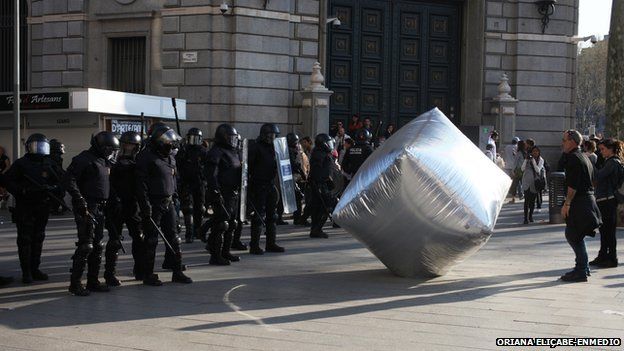'Disobedient objects' chart history of protest at V&A
- Published

Protest movements, from the Suffragettes to Occupy, have produced their own unique items designed to challenge the status quo. And for the first time these "disobedient objects" have been brought together in an exhibition at London's Victoria & Albert museum.
Exhibition co-curator, Gavin Grindon, says these kinds of things have often been overlooked by museums.
Display items include graffiti-writing robots and makeshift gas-masks.
"The idea was to collect together the objects of art and design from activist social movement over the last 30 years," says Grindon, "it's part of an important area that we should be paying attention to."
While 21st Century innovations - such as a robot that paints graffiti - show how technology helps activists develop new tactics, bone china produced by the Suffragette movement, emblazoned with a logo designed by Sylvia Pankhurst, illustrates the methods used to take the struggle for the vote into Edwardian drawing rooms.
The exhibition is arranged into sections which each show a different strategy used to garner social change - direct action, making worlds, solidarity, and speaking out.
Some of the items from protest camps are "very practical but at the same time... very utopian," says Grindon.
Items like makeshift gas masks made by anti-government protesters at Gezi Park in Istanbul show the "simple means" but "rich ends" of the objects, he adds.
"People were producing gas masks out of plastic bottles and surgical masks pressed down into them, because during the protests... record amounts of teargas were being used against the protesters to try to clear them.
"So people began to improvise with new ways to... resist and support each other."
"A lot of these objects have their own provenance, they're dirty, they have holes in, often from police truncheons," says Grindon.
"And they're objects that are made for a particular moment.
"There's a kind of interesting interface between these very traditional hand-crafted items, and the individual placard. When you think of demonstrations, often they involve lots of uniform placards, that show the solidarity of groups, show them as one mass.
"But from about 2009, that started to change, and people started very often at demonstrations to have a huge variety of different hand-made placards."
While objects like inflatable cobblestones, used by protesters in Berlin and Barcelona in 2012, are designed to confuse and mock the authorities, others are made with the media firmly in mind.
"I think lots of people had Twitter accounts and they were very aware that the thing they were carrying was going to be photographed and was going to be tweeted," explains Grindon.
"So on the one hand it's this very hand-made, naive item, and on the other, they are making it with the knowledge of its interface with the latest technology.
"In essence it's a hand-made tweet."
Defacing coins and banknotes to circulate a message has a long history, and the exhibition includes notes produced by the Occupy movement.
The Occupy George note was produced with "a stamp that you could print onto a dollar bill that would divide in it half, turning it into a diagram telling you how much of that bill went to the richest 400 in America, and how much went to everyone else," says Grindon.
A 1989 "democracy note" from Burma carries a more subtle message, but one that was just as challenging:
"It's a one-kyat note from Burma which represents General Aung San. But what it doesn't represent is his daughter, (pro-democracy activist) Aung Sang Suu Kyi, who it was illegal to produce images of," says Grindon.
"The artists who produced the note - when they did the watermark, softened the features of the General, so that if you held it up to the light, you had a secret portrait of Aung San Suu Kyi."
We don't know the fate of the subversive artist - but what happened to the notes?
"They were withdrawn."
Gavin Grindon was talking to Radio 4's Front Row on 21 July. The interview is available to hear on the BBC website.
Disobedient Objects opens at the Victoria and & Albert Museum on 26 July and runs until 1 February 2015.
- Published24 July 2014
- Published2 June 2014
- Published17 June 2014